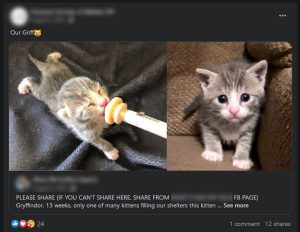Running an animal shelter is tough, and most operate on a tight budget. Between staff salaries, supplies, animal food and water, veterinary bills, and just keeping the lights on, advertising and promotional expenses often fall to the bottom of the to-do list.
Simply caring for animals is not enough. The success of an animal shelter depends on its ability to find loving homes for the animals – and to raise money to do so.
A marketing plan helps a shelter allocate its resources in a more effective and efficient manner. This helps ensure that its budget is being used in the most impactful way. A written marketing plan and schedule provides direction while saving time and money. Without one, your shelter may struggle to reach the right audience or make the most of its promotional efforts.\

Don’t worry. You’ve got this!
Here are the elements you need to put together an animal shelter marketing plan:
Define your target audience
Who are you trying to reach, when are you trying to reach them, and why? Some common target audiences for animal shelters include:
- Pet lovers: These are people who are passionate about animals, love hearing about them, and are likely to consider adopting a pet or two.
- Families: Families with children are often looking for a dog or cat to add to their household. They are often interested in kittens and puppies that have energy and will play with the children.
- Young professionals: This group is often looking for a pet to keep them company. They often prefer a more low-maintenance animal like a cat or small dog.
- Seniors: Seniors may be looking for a pet to provide comfort and companionship in their golden years. Older animals that have been rescued or surrendered are often a good choice for elderly adopters.
- Animal advocates: These are individuals who are actively involved in animal welfare and are likely to support a shelter’s mission through volunteering and/or donating.
Each target audience requires its own messaging and marketing strategies. You should tailor your advertising to their specific needs.

Editable template from Shelter Roundtable.
Determine your shelter’s unique value proposition
Determining your Unique Value Proposition (UVP) is an important step in developing a successful marketing plan. Your shelter’s UVP is what sets it apart from others and highlights what makes your organization special and valuable to the community.
Some common elements of a shelter’s UVP include:
- Mission: Your shelter’s specific mission, values, and approach to the welfare of animals can set it apart from others.
- Location: Your location is often a unique selling point, especially if your shelter is easily accessible to your target audience.
- Services: What unique services do you provide? Rehabilitation, training, crematory, and veterinary care may not be known to the public and should be promoted.
- Quality of care: How your shelter cares for animals, such as providing high-quality food, medical care, and rehabilitation can make it stand out from others.
- Adoption process: Your shelter’s adoption process, including screening, counseling, and follow-up support, can set it apart from others and demonstrate its commitment to finding the right match for each animal.
All these elements help create a reputation and a strong brand. Find ways to highlight the elements of your UVP in your advertising and promotional efforts. This can attract potential adopters and supporters who are looking for a shelter that aligns with their own values and priorities.
Outline your marketing budget and resources
All the plans in the world don’t help if you don’t have the means to put them into place. For animal rescues and shelters, it is critical to have a budget in place and resources allocated to get the job done.
When writing up and outlining your marketing plan, consider these factors:
- Allocation of funds: Determine the amount of money to be spent on each marketing channel or campaign. This can be on a quarterly or annual basis.
- Resources: Identify the internal and external resources required. This often becomes a staffing issue with personnel, along with technology and individual skills.
- Timing: Create a timeline for your marketing activities and allocate your budget accordingly. For example, you may need spend more to promote adoptions during the holidays.
- Measurable goals: Set realistic budget targets that can be measured and adjusted based on performance. This can include money raised, number of adoptions, new donors, volunteers, and supporters.
- Contingency plans: If things go off the rails, make contingency plans and budget accordingly.
Once you have a budget in place, it is important to regularly review it to see what is working and what is not performing so well. Adjust your spending and resource allocation to ensure maximum effectiveness.
Develop a strong online presence
Build a website and social media profiles that accurately represent the animal shelter, its values and mission. For ongoing outreach, post regularly to social media accounts, such as Facebook, Instagram, and Twitter. People love pictures, videos, and stories of animals, and animal shelters and rescues tend to do extremely well on these platforms.
Plan your social media content out in advance. Use your adoption ads and fundraising events, pet-themed holidays, and other important dates to lay out a schedule.
Online advertising platforms such as Google Ads, Facebook, and Instagram provide a powerful way to reach potential adopters in the area. These paid advertising platforms offer advanced targeting options that allow advertisers to reach their target audience based on demographics, specific interests, and behaviors.
Utilize email marketing to keep connected
Regularly send newsletters and updates to subscribers to keep them informed about the animal shelter and its activities. Some benefits of sending newsletters and updates include:
Regular communication keeps your shelter top of mind with your subscribers. By including calls-to-action in each update, you can drive engagement and encourage subscribers to act, such as attending events, donating, or adopting an animal.
Pro Tip: Segment your subscriber lists by specific groups, such as adopters, donors, and volunteers, and provide tailored content that is relevant to their interests.
To maximize the impact of your emails, make sure that they are well-designed, well-written, and include engaging content, such as stories of rescued animals and successful, happy adoption families.
Email marketing can help build a sense of community around your organization’s mission and values. It helps people stay connected, even when they are unable to visit the shelter in person.
Take our free Shelter Email Marketing Course.
Use storytelling as a central marketing component
Highlight stories of rescued animals and their journeys to their forever homes to build emotional connection with potential adopters. Sharing both sad and positive stories can help build an emotional connection and can help potential adopters see the animals as individuals with personalities and histories, rather than just pets.
Sharing the stories of rescued animals can also help to raise awareness about your mission and values. Your stories can be shared through a variety of channels, including the shelter’s website, social media profiles, and email newsletters. Including high-quality photos and videos can help to bring the stories to life and further the emotional connection.

Host events
Host adoption events, fundraisers, and educational workshops to engage with the community and promote the shelter’s mission. Partner with local pet stores, veterinary clinics, and other animal-related businesses to cross-promote services and events.
To maximize the impact of events, it is important to promote them effectively, including through the shelter’s website, social media profiles, email newsletters, and local media outlets. Hosting events regularly can help to build a community around the animal shelter and its mission and generate ongoing support.
Measure and track your success
Regularly track and measure the success of your marketing plan. Online tracking can be done through metrics like website traffic, social media engagement, volunteer, and adoption applications, along with online fundraising totals.
Offline tracking includes foot traffic to your shelter, adoption rates for your dogs and cats, supply donations and even mailed in check donations.
By tracking results to specific advertising campaigns, you can learn what resonates with your audience and brings in the best results. Using that data, you adjust and optimize future campaigns.
Put together a solid marketing schedule
A social media schedule should include a plan for what content will be posted on each platform, when it will be posted, and who will be responsible for posting it. A social media schedule can also include information about what type of content will be posted. These can include marketing ideas such as pet adoption stories, event updates, or educational posts.
Your email marketing schedule should include a plan for when email newsletters are sent, what type of content will be included in each email, and who is responsible for creating and sending them out.
Some newsletter content is “evergreen”, such as requests for donations and general contact information. This information is typically at the bottom of the emails. Your marketing calendar should define what new material should be included with each newsletter.
Make checklists for your social media posts and newsletters
Combining checklists with your marketing schedule will help to ensure that all tasks are completed on time and in an organized manner. This will give you more consistent and effective results.
Social media checklist: A social media checklist should include all the tasks that need to be completed before, during, and after each post, such as creating the content, scheduling the post, monitoring comments and mentions, and tracking the results.
Email marketing checklist: An checklist for your email efforts should include all the tasks that need to be completed before, during, and after each email. They includes creating the content, building the email, testing the email, and tracking openings and clickthroughs.
Both your social media and email marketing schedules and checklists should be regularly reviewed to ensure that all tasks are being completed on time and that things are running smoothly. If there are any issues, such as certain content not hitting the mark or scheduled posts not being added on time, adjust your actions to resolve them.
By writing out a solid marketing plan and means to implement it, you can ensure that your shelter’s promotional efforts are consistent, organized, and effective. This will help you reach your target audience, engage with potential adopters, and ultimately increase the number of animals adopted out!






0 Comments